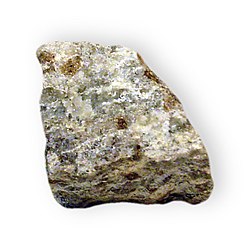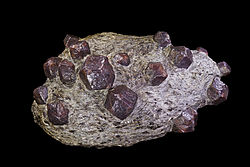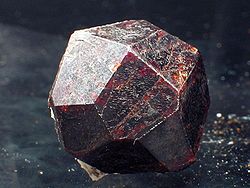Geominerals/Nesosilicates

"Nesosilicates constitute an isolated silicon tetrahedra, in the form of orthosilicate ion (SiO4−
4), which is connected only by interstitial cations [54]."[1]
"Zinc (ortho)germanate is a semiconductor ceramic material, with wide gap energy (4.7 eV)
[[2], [3], [4], [5], [6]] and derived from the minerals phenakite (a fairly rare nesosilicate mineral consisting of beryllium orthosilicate, Be
2SiO
4) and willemite (a zinc silicate mineral, Zn
2SiO
4)."[2]
The two terms "nesosilicate" and "orthosilicate" appear to refer to and often do refer to the same minerals, but there is a difference. The first refers to structure irrespective of chemistry of formation and the second refers to that chemistry which usually produces the structure upon crystallization.
Theoretical nesosilicates
[edit | edit source]Def. a "type of silicate crystal structure characterized by the linking of SiO4 tetrahedra through other cations rather than the sharing of oxygens among SiO4 tetrahedra"[3] is called a nesosilicate.
Def. "any salt or ester of orthosilicic acid, M+
4SiO4−
4 or Si(OR)
4"[4] or "any silicate mineral, such as garnet or olivine, in which the SiO
4 tetrahedra do not share oxygen atoms with each other"[4] is called an orthosilicate.
Afwillites
[edit | edit source]
The chemical formula is Ca
3(SiO
3OH)
2·2H
2O. Afwillite (IMA symbol: Afw[5]) is a calcium hydroxide nesosilicate mineral that occurs as glassy, colorless to white prismatic monoclinic crystals, has a Mohs scale hardness between 3 and 4, occurs as an alteration mineral in contact metamorphism of limestone,[6] in association with apophyllite, natrolite, thaumasite, merwinite, spurrite, gehlenite, ettringite, portlandite, hillebrandite, foshagite, brucite and calcite.[6]
It was first described in 1925 for an occurrence in the Dutoitspan Mine, Kimberley, South Africa and was named for Alpheus Fuller Williams (1874–1953), a past official of the De Beers diamond company.[7]
Afwillite has had a couple of formulas:
Afwillite may form in fractured veins of the mineral spurrite. Jennite, afwillite, oyelite and calcite are all minerals that form in layers within spurrite veins. Afwillite, and calcite, may form from precipitated fluids. Jennite is actually an alteration of afwillite, but both formed from calcium silicates through hydration. Laboratory studies determined that afwillite forms at a temperature below 200 °C (392 °F), usually around 100 °C.[9] Afwillite and spurrite are formed through contact metamorphism of limestone.[10] Contact metamorphism is caused by the interaction of rock with heat and/or fluids from a nearby crystallizing silicate magma.[11]
Structurally, afwillite is a nesosilicate with isolated SiO4 tetrahedra.
Afwillite has two oxides:
- 2SiO4, Silicates, and
- 2H2O, oxidanes, with each having about 50 molecular %.
Calcium does not occur as native calcium. Here it links to the oxygens in the silicate tetrahedra and the oxidanes. Afwillite is 47.6 at % silicate and 28.6 at % oxidane.
Afwillite has a complex monoclinic structure, and the silicon tetrahedra in the crystal structure are held together by hydrogen bonds.[12] It has perfect cleavage]] parallel to its (101) and poor cleavage parallel to its (100) faces.[13] It is biaxial and its 2V angle, the measurement from one optical axis to the other optical axis, is 50 – 56 degrees. When viewed under crossed polarizers in a petrographic microscope, it displays first-order orange colors, giving a maximum birefringence of 0.0167 (determined by using the Michel- Levy chart). Afwillite is optically positive. Additionally, it has a prismatic crystal habit.[9] Under a microscope afwillite looks like wollastonite, which is in the same family as afwillite.
Afwillite is composed of double chains that consist of calcium and silicon polyhedral connected to each other by sharing corners and edges. This causes continuous sheets to form parallel to its miller index [-101] faces. The sheets are bonded together by hydrogen bonds and are all connected by Ca-Si-O bonds (Malik and Jeffery, 1976).[12] Each calcium atom is in 6-fold octahedral coordination with the oxygen, and the silicon is in 4-fold tetrahedral coordination around the oxygen. Around each silicon there is one OH group and there are three oxygens that neighbor them.[12] The silicon tetrahedra are arranged so that they share an edge with calcium(1), and silicon(2) shares edges with the calcium(2) and calcium(3) polyhedral.[12] The silicon tetrahedra are held together by the OH group and hydrogen bonding occurs between the hydrogen in the OH and the silicon tetrahedra. Hydrogen bonding is caused because the positive ion, hydrogen, is attracted to negatively charge ions which, in this case, are the silicon tetrahedra.[11]
Alleghanyites
[edit | edit source]
Alleghanyite (International Mineralogical Association (IMA) symbol: Alh[5]) is a moderately rare humite mineral with the formula Mn2+
5(SiO
4)
2(OH)
2,[14] belonging to the nesosilicates class.[14] In general its occurrences are related with metamorphic (metamorphosed) manganese deposits. The mineral is named after Alleghany County, North Carolina, US.[14]
Crystal system: Monoclinic.[14]
Member of the Manganhumite subgroup > Humite group.[14]
Dimorph of Ribbeite.[14]
Isostructural with Chegemite, Chondrodite, Edgrewite, Humite, Hydroxylchondrodite, Hydroxylclinohumite, Jerrygibbsite, Kumtyubeite, Leucophoenicite, Manganhumite, Norbergite, Reinhardbraunsite, Ribbeite, Sonolite.[14]
May occur as pink to red-brown fine-grained masses or rare crystals on vein fractures.[14]
Geological Setting: in veins crosscutting franklinite ore near pegmatites in a metamorphosed stratiform Zn-Mn deposit.[14]
Geological Setting of Type Material: Hydrothermally deposited, in lenses in a manganese-bearing vein.[14]
Associated Minerals at Type Locality: Spessartine, Rhodonite and Galaxite.[14]
Almandines
[edit | edit source]
"Almandine garnet-bearing andesites and dacites occur frequently in the Neogene calc-alkaline volcanic series of the northern Pannonian Basin (Hungary and Slovakia)."[15]
"Coexisting phenocrysts of primary garnets include Ca-rich plagioclase, hornblende (magnesiohastingsite to tschermakite) and/or biotite. The primary garnets have high CaO (>4 wt %) and low MnO contents (<3 wt %). They have strongly light rare earth element depleted patterns and are enriched in heavy rare earth elements."[15]
Almandine (or almandite) has the chemical formula Fe2+3Al2Si3O12.[3]
Andalusites
[edit | edit source]Although andalusite is a metamorphic mineral, it also occurs as in the specimen on the right in volcanic rocks.
Def. an "aluminium nesosilicate mineral, Al2SiO5"[16] is called an andalusite.
Andradites
[edit | edit source]On the right is an image of andradite variety demantoid. Andradite has the formula Ca
3Fe3+
3Si
3O
12.[3] Demantoid andradite is green.[17]
Garnets
[edit | edit source]
"Abundances of rare earth elements, Hf, Sc, Co, Cr and Th in garnet megacrysts and their volcanic hosts or matrices are used to estimate garnet/liquid partition coefficients for these elements."[18]
"The wide variation in garnet/liquid partition coefficients from kimberlites to rhyolites cannot be explained as an effect of temperature and we conclude that a major factor is the composition of the melt from which the garnet crystallized."[18]
"Garnet = Mineral Group of general formula: A3B2(SiO4)3, A = Ca, Mg, Fe2+, Mn2+; B = Al, Fe3+, Cr, V, Zr, Ti."[3]
The garnets make up two solid solution series: pyrope-almandine-spessartine (pyralspite), with the composition range [Mg,Fe,Mn]
3Al
2(SiO
4)
3; and uvarovite-grossular-andradite (ugrandite), with the composition range Ca
3[Cr,Al,Fe]
2(SiO
4)
3.
Def. a "hard transparent mineral that is often used as gemstones and abrasives"[19] is called a garnet.
Kyanites
[edit | edit source]
"Volcanoes of the Eifel district have sampled the total crust. [...] Types with chlorite + clinozoisite + oligoclase, with chlorite + garnet + biotite + clinozoisite + oligoclase lead to types with garnet + clinozoisite within garnet but none outside, kyanite + staurolite + almandite + oligoclase."[20]
Olivines
[edit | edit source]

Def. "[a]ny of a group of olive green magnesium-iron" orthosilicates "that crystallize in the orthorhombic system"[21] is called an olivine.
At right is a visual close up of green sand which is actually olivine crystals that have been eroded from lava rocks. Some olivine crystals are still inside the lava rock.
Forsterite "(Mg2SiO4) is the magnesium rich end-member of the olivine solid solution series."[22]
"Forsterite is associated with igneous and metamorphic rocks and has also been found in meteorites. In 2005 it was also found in cometary dust returned by the Stardust probe.[23] In 2011 it was observed as tiny crystals in the dusty clouds of gas around a forming star.[24]"[22]
"Two polymorphs of forsterite are known: wadsleyite (also orthorhombic) and ringwoodite (isometric). Both are mainly known from meteorites."[22]
Rhodolites
[edit | edit source]
Rhodolite is a varietal name for rose-pink to red mineral pyrope, a species in the garnet group.
Chemically, rhodolite is an iron-magnesium-aluminium silicate, [(Mg,Fe)3Al2(SiO4)3,] part of the pyrope-almandine solid-solution series, with an approximate garnet composition of Py70Al30.
Sillimanites
[edit | edit source]"Ash-flow tuffs of Neogene age exposed over 2,500 km2 in the Macusani region of southeastern Peru are the volcanic equivalent of S-type granites. The strongly peraluminous tuffs contain phenocrysts of andalusite, sillimanite, and muscovite and have high 87Sr/86Sri (0.7258 and 0.7226) and δ18O (+11‰)."[25]
Sillimanite is a nesosilicate.[26]
Sphenes
[edit | edit source]The image on the right is of the mineral sphene. Its molecular formula is CaTiSiO
5. Each crystallographic unit cell of sphene contains at least one molecular unit. The actual space group P 21/a has Z=4 (or four molecules per unit cell).
"Sphene is widely distributed as an accessory mineral in intermediate and felsic plutonic rocks, pegmatites and alpine veins, particularly in coarse-grained igneous rocks such as syenite, nepheline syenite, diorite and granodiorite. It occurs similarly in schists or gneisses and in some metamorphosed limestones."[27]
Staurolites
[edit | edit source]
"Staurolite from the Dry River South volcanic-hosted massive sulfide deposit in northern Queensland, Australia is enriched in ZnO (2.5–6.8%) only within the massive sulfide lens or in highly pyritic biotite-chlorite schist just below the massive sulfide lens."[28]
"Staurolite grains from the Dry River South and other massive sulfide lenses have low TiO2 concentrations (mainly <0.4%) relative to staurolite grains from metasediments and alteration zones (mainly >0.4%). The low concentration of TiO2 in staurolite from the massive sulfide lens results from the low initial Ti concentration in exhalative ores. High ZnO and low TiO2 values are indicative of staurolite associated with Zn-rich massive sulfide."[28]
Tephroites
[edit | edit source]
Uranophanes
[edit | edit source]
Uranophane Ca(UO
2)
2(SiO
3OH)
2·5H
2O is a rare calcium uranium [nesosilicate] hydrate mineral that forms from the oxidation of uranium bearing minerals. Uranophane is also known as uranotile. It has a yellow color and is radioactive.
Hypotheses
[edit | edit source]- Most minerals on Earth are oxides.
See also
[edit | edit source]References
[edit | edit source]- ↑ Ye Eun Chai, Quin R.S. Miller, H. Todd Schaef, Dushyant Barpaga, Reza Bakhshoodeh, Marius Bodor, Tom Van Gerven and Rafael M. Santos (May 2021). "Pressurized in situ X-ray diffraction insights into super/subcritical carbonation reaction pathways of steelmaking slags and constituent silicate minerals". The Journal of Supercritical Fluids 171: 105191. doi:10.1016/j.supflu.2021.105191. https://www.researchgate.net/profile/Rafael-Santos-44/publication/349179415_Chai_et_al_SUPFLU_Supplementary_Material_011021pdf/data/602410d3a6fdcc37a819e799/Chai-et-al-SUPFLU-Supplementary-Material-011021.pdf. Retrieved 27 November 2021.
- ↑ Jéssica I. Viegas, Roberto L. Moreira and Anderson Dias (January 2021). "Optical-vibration and intrinsic dielectric properties of low-k high-Q Zn
2GeO
4 ceramics". Journal of Physics and Chemistry of Solids 148: 109693. doi:10.1016/j.jpcs.2020.109693. https://www.sciencedirect.com/science/article/abs/pii/S0022369720312713. Retrieved 27 November 2021. - ↑ 3.0 3.1 3.2 3.3 3.4 Willard Lincoln Roberts; George Robert Rapp Jr.; Julius Weber (1974). Encyclopedia of Minerals. New York, New York, USA: Van Nostrand Reinhold Company. pp. 693. ISBN 0-442-26820-3.
- ↑ 4.0 4.1 SemperBlotto (18 June 2006). "orthosilicate". San Francisco, California: Wikimedia Foundation, Inc. Retrieved 2013-09-02.
{{cite web}}:|author=has generic name (help) - ↑ 5.0 5.1 Warr, L.N. (2021). "IMA-CNMNC approved mineral symbols". Mineralogical Magazine 85: 291-320. https://www.cambridge.org/core/journals/mineralogical-magazine/article/imacnmnc-approved-mineral-symbols/62311F45ED37831D78603C6E6B25EE0A.
- ↑ 6.0 6.1 Handbook of Mineralogy
- ↑ Webmineral data
- ↑ Hudson Institute of Mineralogy (31 October 2015). "Afwillite". Hudson Institute of Mineralogy. Retrieved 2015-11-05.
- ↑ 9.0 9.1 Kusachi, I, Henmi, C. And Henmi K. (1989) Afwillite and jennite from Fuka, Okayama Prefecture. Japan. Miner J. 14, 279-292.
- ↑ Barthemy, D. (2000) Afwillite Mineral Data, (http://webmineral.com/data/Afwillite.shtml)
- ↑ 11.0 11.1 Klein, C. and Dutrow, K. (2007) Manual of Mineral Science. 23rd Edition, 63, 596
- ↑ 12.0 12.1 12.2 12.3 Malik, K. M. A & Jeffery J. W. (1976) A re-investigation of the structure of afwillite. Acta Crystallographica, B32, 475.
- ↑ Megaw H. D. (1952). The structure of afwillite. Acta Crystallographica, 5, 477.
- ↑ 14.00 14.01 14.02 14.03 14.04 14.05 14.06 14.07 14.08 14.09 14.10 Alleghanyite. Mindat
- ↑ 15.0 15.1 SZ. Harangi; H. Downes; L. Kósa; CS. Szabó; M. F. Thirlwall; P. R. D. Mason; D. Mattey (01 October 2001). "Almandine Garnet in Calc-alkaline Volcanic Rocks of the Northern Pannonian Basin (Eastern–Central Europe): Geochemistry, Petrogenesis and Geodynamic Implications". Journal of Petrology 42 (10): 1813-43. doi:10.1093/petrology/42.10.1813. http://petrology.oxfordjournals.org/content/42/10/1813.full.pdf. Retrieved 2017-02-23.
- ↑ SemperBlotto (18 January 2007). "andalusite". San Francisco, California: Wikimedia Foundation, Inc. Retrieved 2017-02-21.
{{cite web}}:|author=has generic name (help) - ↑ J.M. Duke; M. Bonardi (1982). "Chromian andradite from Reaume Township, Ontario". Canadian Mineralogist 20: 49-53. http://rruff.info/doclib/cm/vol20/CM20_49.pdf. Retrieved 2015-10-23.
- ↑ 18.0 18.1 Anthony J. Irving; Frederick A. Frey (June 1978). "Distribution of trace elements between garnet megacrysts and host volcanic liquids of kimberlitic to rhyolitic composition". Geochimica et Cosmochimica Acta 42 (6): 771-87. doi:10.1016/0016-7037(78)90092-3. http://www.sciencedirect.com/science/article/pii/0016703778900923. Retrieved 2016-02-12.
- ↑ "garnet". San Francisco, California: Wikimedia Foundation, Inc. 21 January 2017. Retrieved 2017-02-21.
- ↑ G. Voll (1983). Karl Fuchs. ed. Crustal Xenoliths and Their Evidence for Crustal Structure Underneath the Eifel Volcanic District, In: Plateau Uplift. Berlin: Springer-Verlag. pp. 336-42. doi:10.1007/978-3-642-69219-2_37. ISBN 978-3-642-69221-5. http://link.springer.com/chapter/10.1007/978-3-642-69219-2_37. Retrieved 2016-02-12.
- ↑ "olivine". San Francisco, California: Wikimedia Foundation, Inc. August 30, 2012. Retrieved 2012-10-23.
- ↑ 22.0 22.1 22.2 "Forsterite". San Francisco, California: Wikimedia Foundation, Inc. October 24, 2012. Retrieved 2013-01-22.
- ↑ Ds. Lauretta; L.P. Keller; S. Messenger (2005). "Supernova olivine from cometary dust". Science 309 (5735): 737–741. doi:10.1126/science.1109602. PMID 15994379.
- ↑ Spitzer sees crystal 'rain' in outer clouds of infant star, Whitney Clavin and Trent Perrotto, Physorg.com, May 27, 2011 . Accessed May 2011
- ↑ Donald C. Noble; Thomas A. Vogel; Paula S. Peterson; Gary P. Landis; Norman K. Grant; Peter A. Jezek; Edwin H. McKee (January 1984). "Rare-element–enriched, S-type ash-flow tuffs containing phenocrysts of muscovite, andalusite, and sillimanite, southeastern Peru". Geology 12 (1): 35-9. doi:10.1130/0091-7613(1984)12<35:RSATCP>2.0.CO;2. http://geology.gsapubs.org/content/12/1/35.short. Retrieved 2017-02-19.
- ↑ Strunz (20 February 2017). "Sillimanite Mineral Data". Web Mineral. Retrieved 2017-02-20.
- ↑ Martine van der Westhuizen (26 November 2010). "Mineral of the Month - Sphene or Titanite". Bothasig, Cape Town, South Africa: The Cape Town Gem & Mineral Club. Retrieved 2015-08-10.
- ↑ 28.0 28.1 David L. Huston (May 1995). "Zincian staurolite in the Dry River South volcanic-hosted massive sulfide deposit, northern Queensland, Australia: an assessment of its usefulness in exploration". Applied Geochemistry 10 (3): 329-336. doi:10.1016/0883-2927(95)00007-7. http://www.sciencedirect.com/science/article/pii/0883292795000077. Retrieved 2017-02-22.
